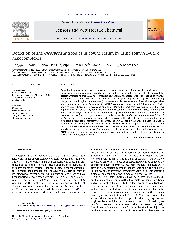摘要
Detecting biomolecules via nanotechnology has become increasingly important in veterinary science. Neosporosis is an infectious disease that primarily affects cattle and it is caused by the intracellular parasite Neospora caninum. This microorganism now appears to a major cause of abortion in dairy cattle worldwide. We report herein on a rapid, sensitive, and inexpensive qualitative approach for detecting neosporosis based on photoluminescence (PL) enhancement between quantum dots (CdTe nanoparticles) and a unique form of spiky Au nanoparticles (SNP). We prepared anti-bovine IgG functionalized-SNPs, and a conjugated structure between quantum dots (QDs) and recombinant N. caninum protein that was expressed by silkworms. They bound easily when their common complementary target, anti-Neospora antibodies (ANABs) in bovine serum, was present. Binding was monitored by the PL enhancement of CdTe nanoparticles (NPs) in the PL spectrum that resulted from localized surface plasmons resonance (LSPR) of SNPs. The fluorescence intensities for samples from infected and healthy cattle were compared, for which significant differences in intensity were observed. The SNP-QDs sandwich nanocomplexes remained in solution and its optical properties allowed it to be easily quantified by using fluorescence spectra. More than 52% emission enhancement on the surface of the SNPs was attained compared with the CdTe NPs and the results were reproducible. Furthermore, the biosensor was suited for qualitatively analyzing ANABs in blood serum. The ease of operation of this system and its generality offer specific advantages over other immunoassay methods.
- 出版日期2013-3-1
